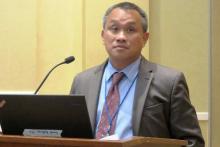BALTIMORE – A few days’ delay in prognostication can make the difference between life and death for patients who are treated with hypothermia after cardiac arrest.*
There’s no doubt now that the cooling technique improves survival and neurologic outcomes after cardiac arrest, Dr. Romergryko Geocadin said at the annual meeting of the American Neurological Association. But there isn’t yet firm consensus on the optimal target temperature, how long cooling and rewarming should last, or how long to wait before recovery can be adequately assessed, said Dr. Geocadin of Johns Hopkins University, Baltimore.
Because these questions remain open, both clinicians and families can make what he called a possibly tragic mistake: assuming too early that all hope is lost.
“The concept of waiting and allowing the tincture of time to work is very straightforward,” said Dr. Geocadin, who is also president of the Neurocritical Care Society. “It’s the problem of nihilism that is so immense. Once we as physicians say a disease is fatal – it is. Because if you predict the patient will die, then you will give up. Then patient will die, and then you will be correct.”
Dr. Geocadin argues that many cardiac arrest patients don’t get the time they need to begin recovery after hypothermic treatment. “The forces against this are sadly aligned” against patience, he said in an interview. Families are in distress and crave answers to difficult questions. Doctors feel pressured to give them, and predict outcomes too early. And, unfortunately, medical economics always lurks in the background. “In the ICU, you are always in a bed crunch. People demand to know why we’re waiting on this patient who is obviously going to have a poor outcome. I would say, what’s more unethical? Sentencing a patient to prolonged existence with little hope, or using insufficient information to predict a fatal outcome? I’m not saying sustain someone for 3 months – but just give it a week before making the decision that treatment is futile.”
No one knows exactly why postarrest hypothermia improves overall survival and good neurologic outcomes, Dr. Geocadin said. Treatment guidelines from the American Academy of Neurology and American Heart Association are scheduled to be released sometime in 2015. But for now, some important questions remain. What’s the best target temperature and how long should it be sustained? How about rewarming? The latest research isn’t finding definitive answers.
In 2013, a randomized trial of 950 patients added to the confusion. Mortality and neurologic recovery were similar whether patients had been cooled to 33° C or a near-normothermic 36° C.
The study suggests that cooling itself might not be the only key outcomes driver, Dr. Geocadin said. A combination of several other factors could also be at play. The real benefit could be in avoiding postresuscitation fever, which is associated with poor outcomes. It’s also possible that hypothermia’s therapeutic bang might actually be because of the improved multidisciplinary critical care protocols that accompany it – stabilizing blood pressure and blood glucose, controlling seizures, and increased clinician vigilance. Or it could simply be a marker of facility quality: A hospital equipped to offer hypothermia will likely be offering other advanced care practices and expert personnel as well.
“But one thing needs to be emphasized,” he said. “Temperature management at either 33° C or 36° C is superior to no temperature management [normothermia or more than 36° C] in comatose, postcardiac arrest patients."
Hypothermia slows down everything, including drug metabolism. “It’s not just cell death that slows or stops. Metabolism of drugs, such as sedatives, slows as well, and this could be related to the delayed brain recovery that we saw in the earlier trials, where neurologic function started to return by about 5-6 days. This could be because of the brain itself being slowed, or the being affected by slowly metabolized drugs. And this is why we need that delay before we can make prognostication about outcomes. We just need to give people a chance to come out of it.”
Dr. Geocadin had no financial disclosures. However, he is a member of the task force creating the new American Academy of Neurology/American Heart Association hypothermia treatment guidelines.
*Correction, 11/14/2014: A portion of the article that incorrectly stated the cardiac arrest hypothermia protocol at Johns Hopkins has been deleted.
On Twitter @alz_gal

